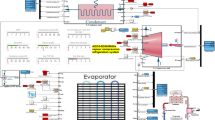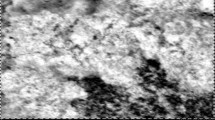Abstract
This paper presents an experimental investigation of energy consumption and heat transfer performance characteristics of a safe mass–charge of liquefied petroleum gas refrigerant, enhanced with varying concentrations of TiO2 nano-lubricants (i.e. 0.2 gL−1, 0.4 gL−1 and 0.6 gL−1) in a domestic refrigerator. Performance parameters investigated at steady state included: instantaneous and mean power consumption, cooling capacity, coefficient of performance (COP), discharge thermal conductivity and discharge temperature. Analysis was based on temperature and pressure readings obtained from appropriate gauges attached to the test rig. Refrigerant properties were obtained from Ref-Prop NIST 9.0 software. Findings showed that reductions in mean power consumption were observed to be 14, 9 and 8% at 0.2 gL−1, 0.4 gL−1 and 0.6 gL−1 nano-lubricants respectively; the highest mean power consumption was obtained using pure compressor mineral oil while the lowest was with 0.2 gL−1 TiO2 nano-lubricant. The estimated mean cooling capacities for the various compressor lubricants were found to be higher with 0.4 gL−1 and 0.6 gL−1 nano-lubricants than pure compressor lubricant, and lower with 0.2 gL−1 nano-lubricant when compared with pure mineral oil lubricant. All the TiO2-based nano-lubricants were of higher instantaneous and mean COP values than the pure lubricant. All nano-lubricant mixtures were also found to give lower discharge temperatures than the pure lubricant. In conclusion, selected TiO2-based nano-lubricants improved the efficiency of the domestic refrigeration system considerably.









Similar content being viewed by others
References
UNEP. The Emissions Gap Report 2015. United Nations Environment Programme (UNEP), Nairobi, 2015.
UNEP. The Emissions Gap Report 2014. United Nations Environment Programme (UNEP), Nairobi, 2014.
Montreal Protocol, United Nations (UN), New York, NY, USA (1987 with subsequent amendments), 1987.
Kyoto Protocol to the United Nations Framework Convention on Climate Change, United Nations (UN), New York, NY, USA, 1997.
Venkataraman M, Padmanabhan V, Senthilkumar P. The use of TiO2 nanoparticles to reduce refrigerator irreversibility. Energy Convers Manag. 2012;59:122–32.
Rasti M, Aghamiri S, Hatamipour M. Energy efficiency enhancement of a domestic refrigerator using R436A and R600a as alternative refrigerants to R134a. Int J Therm Sci. 2013;74:86–94.
Babarinde TO, Ohunakin OS, Adelekan DS, Aasa SA, Oyedepo SO. Experimental study of LPG and R134a refrigerants in vapor compression refrigeration. Int J Energy Clean Environ. 2014;15(2):1–10.
Adelekan DS, Ohunakin OS, Babarinde TO, Odunfa MK, Leramo RO, Oyedepo SO, Badejo DC. Experimental performance of LPG refrigerant charges with varied concentration of TiO2 nano-lubricants in a domestic refrigerator. Case Stud Therm Eng. 2017;9:55–61.
Corbera J, Segurado J, Colbourne D, Gonzálvez J. Review of standards for the use of hydrocarbon refrigerants in A/C, heat pump and refrigeration equipment. Int J Ref. 2008;31:748–56.
Kumar P. Fire disaster following LPG tanker explosion at Chala in Kannur (Kerala, India), August 27, 2012.
Zengin Y, Dursun R, Icer M, Gunduz E, Mansur Durgun H, Erbatur S, Damar O, Güloğlu C. Fire disaster caused by LPG tanker explosion at Lice in Diyarbakır (Turkey): July 21, 2014. Burs. 2015;41:1347–52.
El-Morsi M. Energy and exergy analysis of LPG (liquefied petroleum gas) as a drop in replacement for R134a in domestic refrigerators. Energy. 2014;86:344–53.
Calm JM. The next generation of refrigerants–historical review, considerations, and outlook. Int J Refrig. 2008;31:1123–33.
Bi S, Guo K, Liu Z, Wu J. Performance of a domestic refrigerator using TiO2-R600a nano-refrigerant as working fluid. Energy Convers Manag. 2011;52:733–7.
Harby K. Hydrocarbons and their mixtures as alternatives to environmental unfriendly halogenated refrigerants: an updated overview. Renew Sustain Energy Rev. 2017;73:1247–64.
Bolaji BO, Huan Z. Ozone depletion and global warming: case for the use of natural refrigerant—a review. Renew Sustain Energy Rev. 2013;18:49–54.
Gill J, Singh J, Ohunakin OS, Adelekan DS. Artificial neural network approach for irreversibility performance analysis of domestic refrigerator by utilizing LPG with TiO2-lubricant as replacement of R134a. Int J Ref. 2018;89:159–76.
Gill J, Singh J. Ohunakin OS, Adelekan DS. ANN approach for irreversibility analysis of vapor compression refrigeration system using R134a/LPG blend as replacement of R134a. J Ther Anal Calorim. 2018. https://doi.org/10.1007/s10973-018-7437-y.
Gill J, Singh J. Ohunakin OS, Adelekan DS. Energy analysis of a domestic refrigerator with ANN using LPG/TiO2-lubricant as a replacement for R134a. J Ther Anal Calorim. 2018. https://doi.org/10.1007/s10973-018-7327-3.
Gill J, Singh J, Ohunakin OS, Adelekan DS. Energetic and exergetic analysis of a domestic refrigerator system with LPG as a replacement for R134a refrigerant, using POE lubricant and mineral oil based TiO2-, SiO2- and Al2O3-lubricants. Int J Ref. 2018;91:122–35.
Ohunakin OS, Adelekan DS, Gill J, Atayero AA, Atiba OE, Okokpujie IP, Abam FI. Performance of a hydrocarbon driven domestic refrigerator based on varying concentration of SiO2 nano-lubricant. Int J Ref. 2018;5:2. https://doi.org/10.1016/j.ijrefrig.2018.07.022.
Palm B. Hydrocarbons as refrigerants in small heat pump and refrigeration systems: a review. Int J Ref. 2008;31:552–63.
Ohunakin OS, Adelekan DS, Babarinde TO, Leramo RO, Abam FI, Diarra CD. Experimental investigation of TiO2, SiO2 and Al2O3 lubricants for a domestic refrigerator system using LPG as working fluid. Appl Therm Eng. 2017;127:1469–77.
Schultz R, Cole R. Uncertainty analysis in boiling nucleation. In: AIChE symposium series; 1979.
Sheikholeslami M, Ganji DD. Heat transfer enhancement in an air to water heat exchanger with discontinuous helical turbulators; experimental and numerical studies. Energy. 2016;116:341–52.
Akhavan-Behabadi MA, Sadoughi MK, Darzi M, Fakoor-Pakdaman M. Experimental study on heat transfer characteristics of R600a/POE/CuO nano-refrigerant flow condensation. Exp Therm Fluid Sci. 2015;66:46–52.
Gill J, Singh J. Depicting mass flow rate of R134a/LPG refrigerant through straight and helical coiled adiabatic capillary tubes of vapor compression refrigeration system using artificial neural network approach. Heat Mass Trans. 2018;54:1975–87.
Chen T, Cha DA, Kwon OK. Experimental investigation on mass flow characteristics of R245fa through electronic expansion valve. Appl Therm Eng. 2017;125:111–7.
Sharif MZ, Azmi WH, Redhwan AAM, Mamat R, Yusof TM. Performance analysis of SiO2/PAG nanolubricant in automotive air conditioning system. Int J Ref. 2017;75:204–16.
Bi S, Lin S. Experimental investigation of a refrigerator with a nanorefrigerant. J Tsinghua Univ (Sci Technol). 2007;11:016.
Azmi WH, Sharif MZ, Yusof TM, Rizalman M, Redhwan AAM. Potential of nanorefrigerant and nanolubricant on energy saving in refrigeration system: a review. Renew Sustain Energy Rev. 2017;69:415–28.
Ahamed JU, Saidur R, Masjuki HH. A review on exergy analysis of vapour compression refrigeration system. Renew Sustain Energy Rev. 2011;15:1593–600.
Gill J, Singh J. Energy analysis of vapor compression refrigeration system using mixture of R134a and LPG as refrigerant. Int J Refrig. 2017;84:287–99.
Mahbubul IM, Saidur R, Amalin MA. Thermal conductivity, viscosity and density of R141b refrigerant based nanofluid. Procedia Eng. 2013;56:310–5.
Mostafizur RM, Bhuiyan MHU, Saidur R, Abdul Aziz AR. Thermal conductivity variation for methanol based nanofluids. Int J Heat Mass Transf. 2014;76:350–6.
Bhattad A, Sarkar J, Ghosh P. Improving the performance of refrigeration systems by using nanofluids: a comprehensive review. Renew Sustain Energy Rev. 2017. https://doi.org/10.1016/j.rser.2017.10.097.
Acknowledgements
The authors are grateful to Centre for Research, Innovation and Discovery (CUCRID), Covenant University, Ogun State, Nigeria, for all the necessary assistance and funding needed to carry out this work.
Author information
Authors and Affiliations
Corresponding author
Rights and permissions
About this article
Cite this article
Adelekan, D.S., Ohunakin, O.S., Gill, J. et al. Experimental performance of a safe charge of LPG refrigerant enhanced with varying concentrations of TiO2 nano-lubricant in a domestic refrigerator. J Therm Anal Calorim 136, 2439–2448 (2019). https://doi.org/10.1007/s10973-018-7879-2
Received:
Accepted:
Published:
Issue Date:
DOI: https://doi.org/10.1007/s10973-018-7879-2




